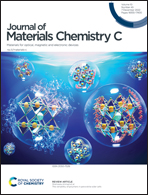Understanding the emission from dendrimers composed of thermally activated delayed fluorescence-based dendrons and a phosphorescent fac-tris[2-(thiophen-2-yl)-4-(phenyl)quinoline]iridium(iii) core†
Abstract
Two light-emitting dendrimers composed of red phosphorescent fac-tris[2-(thiophen-2-yl)-4-(phenyl)quinoline]iridium(III) cores and either blue (BR) or green (GR) thermally activated delayed fluorescence-based (TADF-based) dendrons have been prepared. The dendrimer emission in solution was found to be primarily from the phosphorescent core independent of the dielectric constant of the solvent used. Irrespective of the medium, time-resolved emission spectroscopy (TRES) at room temperature and 77 K provided evidence for the dendrons acting as energy pools for emission from the core. The maximum solution photoluminescence quantum yields (PLQYs) of both dendrimers was around 60%, which was similar to the model core, fac-tris[2-(thiophen-2-yl)-4-(p-tolyl)quinoline]iridium(III) (TQIr). The neat film PLQY values were lower, being 19% and 8% for BR and GR, respectively. However, when blended with tris(4-carbazoyl-9-ylphenyl)amine (TCTA) at low concentration the film PLQY values increased to the value measured for TQIr in solution (≈60%) indicating that the smaller neat film PLQY values was due to intermolecular interchromophore interactions. The external quantum efficiencies (EQEs) for bilayer OLEDs containing the neat emissive layers of BR and GR were 2.6% and 0.9%, respectively, which was consistent with the low PLQY values of the neat films. Finally, the solution processed OLEDs fabricated using 0.1 mol% of BR and GR blended with TCTA resulted in red emission with maximum EQEs of 13.5% and 11.0%, respectively.
![Graphical abstract: Understanding the emission from dendrimers composed of thermally activated delayed fluorescence-based dendrons and a phosphorescent fac-tris[2-(thiophen-2-yl)-4-(phenyl)quinoline]iridium(iii) core](/en/Image/Get?imageInfo.ImageType=GA&imageInfo.ImageIdentifier.ManuscriptID=D2TC03979F&imageInfo.ImageIdentifier.Year=2022)


 Please wait while we load your content...
Please wait while we load your content...